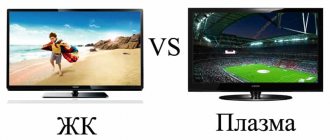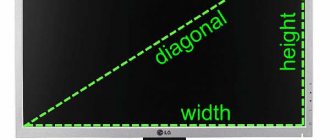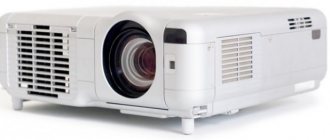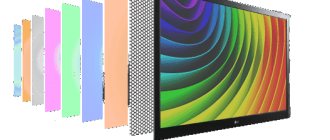Plasma TVs have earned great popularity among users over the years of their development. It was the image quality that enabled plasma devices to occupy leading positions in the television screen market until the introduction of ultra-high resolution Ultra HD in 2014. This article was written in 2014 and the information is current at that time. In 2015, there were no longer plasma TVs from world brands on sale. The situation is the same in 2016, plasma left the TV screen market.
Features of plasma TVs
The secret of a high-quality plasma image lies in its design. The panel screen consists of glass plates, between which there are inert gases with phosphors.
The gas filler is distributed into tiny cells. Under the influence of electricity, it turns into plasma - the cells are illuminated by it and form a picture that we see on the screen.
The production of plasma TVs required large expenditures from manufacturers. Therefore, already in 2013-2014, the production of these devices was reduced to 1%. But the latest lines are still sold in stores, and at fairly high prices.
When choosing a “plasma”, you need to take into account that this is a large and rather heavy device. The standard panel screen size starts at 42 inches. Some plasma models require external speakers, which means even more space will be required to accommodate equipment.
An important feature of “plasma” is its high energy consumption. The normal indicator for this type of TV is 250-500 W.
Plasma panels in recent years have been created using energy-saving technologies. Therefore, if a TV has high power consumption, it is most likely equipped with outdated hardware.
When choosing a “plasma”, the number of ports and tuners, types of audio system, and the presence of smart functions are of great importance. Our review of the best plasma TVs will help you understand all these nuances.
Recommendations: 12 Best LED TVs
12 Best Inexpensive TVs
13 best TVs
Principle of operation
Studying how TV works allows you to identify the strengths and weaknesses of the technology. Ordinary users, due to lack of knowledge, are not able to determine which TV is better - plasma or liquid crystal. This material was created especially for them.
Now let's carefully study the specific features of both technologies. Based on this information, we will create a list of advantages and disadvantages. This is the only way to make an objective assessment of the equipment on the market.
Plasma panel
Plasma TV technology (based on the use of ionized gas) was one of the first to appear. When the first plasma TVs entered the market, they still lost out to competition from cathode ray tube technology. Why? The rationale is very simple. The new product was much more expensive than analogues with identical functionality.
A plasma panel is 2 glass plates, between which there is a matrix consisting of cells filled with ionized gas. Voltage is supplied to the cells through transparent electrodes. The gas is converted into plasma and begins to glow.
Ultraviolet radiation from the plasma provides illumination of the phosphor in three colors: red, green and blue. It is the listed shades in various proportions that are controlled by a computer. You also see them when you turn on the TV.
Which TV to choose - plasma or LCD? There are fewer and fewer plasma models every year. This technology is significantly outdated. Some companies still continue to produce plasmas, improving the image quality and performance parameters of the device as a whole. The screen diagonal increases; on a small display it is impossible to achieve maximum picture detail due to the low resolution.
Now let's analyze the advantages and disadvantages of plasma TVs. Let's start with the positive qualities:
- deep, bright and rich color palette;
- impressive contrast and perfect black depth;
- maximum viewing angle up to 180 degrees;
- long service life - up to 30 years;
- availability of 3D technology.
There are also disadvantages:
- increased energy consumption;
- the image fades when the screen is exposed to sunlight;
- heavy weight, which causes problems with mounting on the wall;
- Pixels burn out in a static image.
That's all you need to know about plasma TVs.
LCD TV
Plasmas appeared quite a long time ago. Their appearance marked the beginning of a new era in the TV equipment industry. LCD technology appeared even earlier. It’s just that it wasn’t immediately used in the TV industry.
The very first LCD display was created back in the early 70s of the last century. Monochrome screens were installed by specialists on watches, calculators and various other devices. A little later, laptops with LCD displays appeared, but they were very primitive. Especially if we draw parallels with modern LCD TVs.
Liquid crystal technology in the production of TV equipment began to be used only in the 2000s. Initially, models with a small screen diagonal - from 14 to 32 inches - appeared on the market. They interested users with high-quality images and affordable prices. Popularity has increased significantly. The novelty has suddenly turned into a real bestseller. However, back then LCD TVs were significantly inferior to their analogues in terms of picture quality.
What is an LCD TV? This is an LCD display based on liquid crystals. They are placed between several layers of polymer and glass plates. A layer of crystals forms a matrix with a large number of pixels. The glow is provided by the backlight located behind the panel. Color is guaranteed by the RGB matrix.
It was the advent of liquid crystal TV that caused CRT TVs to leave the market. Some CRT models were no inferior in image quality, but consumers still preferred the new technology.
Advantages:
- small amount of electricity consumed;
- no static image;
- even a small screen can display images in Full HD;
- relatively low cost;
- compact dimensions and low weight.
Flaws:
- LED and plasma TVs have better contrast;
- limited viewing angle;
- unsatisfactory depth of black color;
- There is no option to change the resolution;
- Not the best response time.
The list of strengths and weaknesses may vary depending on the TV model, or more precisely, on its cost. Much depends on the manufacturer. Premium-class branded equipment has always had a wide viewing angle and excellent contrast. The cheapest devices have an even larger list of weaknesses. The service life of LCD TV is approximately 7-10 years.
Best Budget Plasma TVs
This category includes models with screen diagonals from 42 to 55 inches. Most of them are aimed at watching traditional TV, but the latest models are equipped with Smart functions. The screens comply with the HDTV standard, which is capable of broadcasting digital channels in a resolution of 720x1080 pixels.
LG 50PB6600
4.9
★★★★★
editorial assessment
92%
buyers recommend this product
Unlike most plasmas, the LG50PB6600 model is brighter than even LCD TVs. In normal room lighting, the screen produces a high level of brightness with pronounced blacks. The quality of color reproduction does not deteriorate even from a viewing angle of 160°.
Smart TV functions provide access to premium Internet services: Netflix, Hulu, Youtube. The 20W two-channel speaker system provides optimal volume levels.
Advantages:
- high brightness;
- many image settings;
- realistic rendering of scenes with fast movement;
- Beautiful design.
Flaws:
- delays in video games;
- 3D format cannot be played.
The screen of this 50-inch TV will be appropriate in the living room or bedroom.
Pioneer Kuro PDP-5020FD
4.8
★★★★★
editorial assessment
90%
buyers recommend this product
The model became a successful experience for Pioneer in creating ultra-flat screens. The 50-inch diagonal plasma panel produces rich colors with five times deeper black levels.
The brightness of the image automatically adjusts to the lighting and temperature in the room. The TV is equipped with 8 ports through which you can transfer video from various media, music and digital photos to the screen.
Advantages:
- flexible image settings;
- the presence of an 18-watt stereo amplifier;
- removable speakers;
- built-in media gallery.
Flaws:
- lack of Wi-Fi connection;
- It will be difficult to find on sale, but you can order it online.
The Kuro-5020FD remains popular among plasma fans, although it can only be purchased in intermediary stores or on eBay.
Vizio VP50HDTV20A
4.8
★★★★★
editorial assessment
88%
buyers recommend this product
The main feature of the model is VCV technology, thanks to which the screen displays 1.07 billion colors. The contrast ratio of 15,000:1, unusual for a plasma, is also impressive.
The HDTV format provides images that meet home theater standards. And seven ports allow you to connect additional equipment - from DVD players to computers.
Advantages:
- wide viewing angles - up to 170°;
- picture-in-picture function;
- service life - 60,000 hours.
Flaws:
- lack of Smart TV;
- wide screen frames.
The TV can be used in the living room - as an independent device or part of a home theater.
READ ALSO
12 Best 55-Inch LCD TVs
Differences between LCD and plasma
Now let's analyze the main differences between these technologies. Liquid crystal devices have become increasingly popular. The growing interest from consumers is explained by the fact that users cannot allocate a separate room specifically for watching TV. Mass production made production cheaper.
Dimensions are the key difference between these devices. Liquid crystal technology makes it possible to create very compact and lightweight TVs. Plasmas are limited in size. For example, you won't find models with a screen diagonal larger than 65 inches.
LCD TVs also weigh much less. This is due to the use of plastic screens. Plasmas are equipped with glass displays. This specific feature also helps reduce unnecessary expenses, such as shipping fees. The process of installing the device on the wall is greatly simplified.
When choosing a TV, pay attention to the amount of electricity consumed. Liquid crystal models consume much less electricity. Devices equipped with ECO backlighting will exhibit plasma-level brightness, but will use half the energy.
Which TV is better - LCD, plasma or LED? When answering this question, you need to take into account the service life of the device. LCDs can operate for about 10 years – 60 thousand hours. Initially, plasmas had a long service life, but after 20 thousand hours of continuous operation, the brightness of the picture was halved. Today this flaw has been leveled out by manufacturers. The devices will last approximately the same.
The best plasma TVs for the average budget
The screen diagonal in this group of TVs is 60-65 inches. In addition to improved images, they are distinguished by the presence of Smart-TV and audio systems with cinema sound.
Panasonic TC-P65ZT60
5.0
★★★★★
editorial assessment
97%
buyers recommend this product
Since its appearance on the market, this model has remained the best-selling plasma TV. The screen is made with only one glass plate, which maximizes image quality.
The dual-core Hexa processor ensures excellent reproduction of dynamic scenes. Smart-TV functions provide access to Internet content. You can transfer files from other gadgets to the screen via a USB port or Bluetooth.
Advantages:
- the ability to create personal settings for each family member;
- voice control;
- no glare on the screen;
- Smart functions.
Flaws:
- strong heating of the case;
- heavy weight - 62 kg.
With a 65-inch diagonal screen and excellent picture quality, the TV is ideal for a spacious living room.
LG 60PB6900
4.8
★★★★★
editorial assessment
90%
buyers recommend this product
This model has become one of LG's best-selling plasma panels thanks to the presence of Smart-TV and 3D playback.
The brightness of the screen is somewhat inferior to LCD models, but it perfectly reproduces shades, including realistic black. The Smart-TV platform is a bit stripped down, although it provides access to popular video streaming resources.
Advantages:
- loud and spacious sound;
- high image clarity;
- optimal processor speed in dynamic scenes;
- support for 3D content.
Flaws:
- lack of 3D glasses included;
- The screen dims when the room is brightly lit.
LG 60PB6900 is a good option for watching television and Internet content. It may be a bit weak for video games.
VM60P-60
4.6
★★★★★
editorial assessment
86%
buyers recommend this product
The TV attracts attention with its durable aluminum casing. With an impressive 60-inch screen size, it doesn't look bulky since the speakers are located at the bottom.
VCV technology is responsible for the realistic transmission of 1 billion shades. Two built-in TV tuners provide reception of analog and digital channels. And TruSurround XT audio technology improves sound quality to movie theater standards.
Advantages:
- high contrast ratio - 7000:1;
- improved sound and picture;
- presence of 14 ports;
- Possibility of mounting on a stand or wall.
Flaws:
- no Smart TV function;
- difficult to find in a regular store.
High signal processing speed provides excellent images when watching sports programs and dynamic films. The TV can also be used as a monitor for game consoles.
READ ALSO
13 best TVs for the kitchen
Cleaning the screen
Improper care of the TV will lead to the appearance of various stains on the screen, glare, scratches, which will not contribute to comfortable viewing. Dust on the screen accumulates static electricity. It should be taken into account that the screen of a plasma device consists of several layers, each of which is sensitive to the effects of aggressive chemicals.
General recommendations on how to clean the surface of a plasma TV screen:
- Carry out cleaning in a room with sufficient lighting;
- disconnect the TV from the network - a safety rule, wait until it cools down completely;
- to remove dust, use a soft, lint-free cloth: cotton, fleece or flannel;
- Use recommended cleaning products to remove dirt;
- Do not press on the screen or use scrapers;
- Do not spray chemicals directly onto the screen. A microfiber cloth or soft, lint-free cloth is suitable for this. Make the napkin damp, but not wet;
- Do not turn on the TV until the screen is completely dry.
The TV body must also be regularly wiped with a soft cloth. Specialized stores sell wet wipes for caring for LCD TV screens. Wipes impregnated with a special composition do not contain alcohol or abrasive components and can be used for any type of screen.
How to clean a plasma TV at home. Prepare a soap solution from baby soap. Laundry soap is not recommended for use due to its high alkali content. Use a soft, lint-free cloth soaked in the solution to wipe the screen. Use a well-wrung cloth to remove any remaining soap and wipe the screen dry.
The best premium plasma TVs
The high price of goods from this category is determined not only by the size of the panel. Elite “plasmas” are distinguished by ideal image quality, long service life and a high level of energy saving. Models that have not yet been discontinued are also expensive.
Panasonic TH-85PF12W
4.9
★★★★★
editorial assessment
96%
buyers recommend this product
The main advantage of the model is its brightness, which is twice as high as that of standard plasmas. It is provided by NeoPDP technology, which enhances the light signal and at the same time saves energy.
The screen size corresponds to cinema standards - 1889x1062 mm. Thanks to three slots, you can connect other devices to the TV via LAN, Dual Link HD-SDI and DVI interfaces. And through the RS232 port you can connect to the smart home system.
Advantages:
- service life 100,000 hours;
- the ability to enlarge the image;
- impact-resistant glass;
- extensive port park.
Flaws:
- lack of TV tuner;
- high price - from 450,000 rubles.
This plasma panel is designed for use in home theaters, cafes and hotel lobbies.
Runco V-50HD
4.7
★★★★★
editorial assessment
88%
buyers recommend this product
Despite the diagonal of 50 inches, the Runco plasma panel has a high price - from 600,000 rubles. The TV is equipped with the necessary set of functions for viewing TV content and video.
The screen displays images in Full HD format. 160° viewing angles maintain excellent color reproduction even when viewed from the side. Eight ports allow you to connect a video player, computer and other devices to the TV.
Advantages:
- 3D support;
- reception of digital channels;
- built-in audio system;
- high contrast ratio 10000:1;
- minimum power consumption in standby mode (1 W).
Flaws:
- lack of Bluetooth;
- no Wi-Fi – network connection only via Ethernet.
The TV will be a good purchase for fans of traditional television who have little interest in Internet content. True, the inflated cost of this model will scare off many.
Is it worth taking plasma?
Panasonic exhibited its largest plasma TV in 2010 at the Consumer Electronics Show in Las Vegas. Model TH-152UX1: diagonal – 152 inches (386 cm), weight – 580 kg. The plasma panel produces a resolution of 4096 × 2160 pixels and can display 3D content.
Plasma would be a good choice if the user needs a large diagonal screen at a reasonable cost. A plasma with a good anti-reflective coating will look better in a bright room than an LCD with a glossy finish.
At the moment, only Samsung produces plasma panels. So there's not much choice.
Important parameters and characteristics
Technical characteristics are of primary importance in choosing a good quality TV. The buyer must rely on the following criteria :
- Screen brightness;
- Diagonal;
- Permission;
- Matrix type;
- Backlight;
- Contrast.
The image quality depends on these characteristics.
Matrix resolution
Resolution refers to the number of horizontal and vertical pixels that make up the screen. The standard is a Full HD display with a resolution of 1920x1080 pixels. In addition to Full HD, monitors with resolutions of HD (1280x720), 4K/UltraHD (3840x2160) are available.
The higher the resolution, the more detailed the picture is.
But small displays don't require high 4K resolution. Not much content is created for 4K resolution - films, television shows, and videos from the Internet are produced in Full HD. The optimal solution would be to purchase a Full HD screen.
Matrix type
The type of matrix is influenced by the properties the device has and the price. The quality of the image, its brightness and contrast depend on the matrix. The latest generations of matrices operate on liquid crystals. This allows you to create interesting optical results.
The display structure consists of pixels that determine the appearance of the matrix. A pixel represents the colors that make up an image. To understand which TV is better to choose based on the type of matrix, you need to study their varieties.
Plasma
Plasma models are practically not used anymore. The screen is made not of crystals filled with liquid, but of cells filled with gas.
This design provides a high-quality picture and does not fade.
The main disadvantage is the high energy consumption.
And the plasma panel cannot be made small - the minimum diagonal will be 32 inches.
TFT
Thin Film Transistor technology is that the display is based on an active matrix of thin-film transistors. The crystals are installed in a spiral. When voltage is applied to the matrix, the crystals turn towards each other and a black color is formed. When there is no voltage, the crystals turn white. By changing the voltage, you can achieve any color on a pixel.
The main advantage of such displays is their low price. Such screens have high brightness and short response time
. TFT technology is used in budget screens.
Disadvantages - low color rendering, insufficient contrast, the appearance of “dead” pixels.
IPS
Matrix with IPS technology is an improved version of the TFT display. The crystals lie in the same plane parallel to each other. In the absence of current, the cell remains black. When voltage is applied, the crystal rotates, light passes through the installed filters, and the necessary shades appear on the pixels.
Advantages of IPS:
- Increased viewing angle;
- Color rendering quality;
- Contrast;
- Low power consumption;
- “Broken” and empty pixels do not appear.
Disadvantages include reduced image brightness and long response time. And also IPS technology is expensive, which affects the cost of the finished product.
V.A.
The VA technology was manufactured by the Japanese company Fujitsu. The abbreviation stands for “vertical alignment”. An important feature of this technology is the ability to mix crystals with neighboring ones. This allows you to get rich shades of the picture. The arrangement of the crystals produces a natural black color.
TVs with VA display are suitable for use in large rooms, conference rooms, and sports bars.
OLED and QLED
LED, OLED, QLED image transmission technologies have almost replaced other types. LED displays account for approximately 90% of the total market. LED screens allow you to create a bright, rich picture, and the monitor itself will be thin.
OLED screen is based on organic light-emitting diodes. The diodes do not require additional lighting, as they glow on their own.
Organic LED screens are distinguished by high image contrast, accurate color reproduction, rich black color, and a wide viewing angle.
LED screens have low electricity consumption. The disadvantages of such models are high cost and burnout after several years of intensive use.
QLED technology was developed by Samsung. The main difference is that instead of classical light filters, the screen uses an ultra-thin film based on quantum dots. This improves the brightness and contrast of the image. The price of such TVs is high. After intensive daily use, pixels also burn out.
If we compare all types of displays, we can conclude that it is better to take a standard LED screen. It will last longer, and its characteristics are at a high level.
Screen type
The image quality depends on the screen backlight. There are 2 types of backlighting - Edge LED and Direct LED. The first type is used in modern devices with a large viewing angle of up to 178 degrees. LEDs are located along the contour of the display and form a luminous frame. Advantages of Edge LED:
- Matrix brightness;
- Contrast;
- Design of the finished product;
- Slim body.
Flaws:
- Difficulty of repair;
- Bleach areas may appear;
- More energy is required than Direct LED.
In Direct LED technology, LEDs are placed over the entire surface.
Advantages of Direct LED:
- Uniform distribution of the light field;
- No glare;
- Low power consumption;
- Inexpensive compared to Edge LED;
- Can be repaired.
The disadvantage is that the screen is thicker and has lower brightness compared to Edge LED.
Which TV is best to buy based on the type of backlight depends on the location. Products with edge LED are best installed on flat walls. Direct LED can be purchased for installation in a suspended or inclined state - then the light diffuser will not be deformed. And you also need to remember that edge LED is brighter than Direct LED.
There are flat and curved screen TVs on the market. This development is not related to the user’s convenience when watching programs, but to marketing and the race of manufacturers. A TV with a curved screen must only be viewed from a certain angle at a specified distance, otherwise the image will be distorted. Watching programs with your family at home on such a screen is inconvenient, so it is recommended to purchase products with a classic flat-panel monitor.
With or without Smart TV
Smart TV provides a set of built-in applications for broadcasting videos from the Internet directly to your TV. Wi-Fi or an Internet port is used to receive content.
If you have a high-quality and stable Internet, you can refuse wires, antennas, and the services of cable television operators.
Since the technology is actively promoted by Samsung, the platform is usually Android with a set of applications from Google Play.
The disadvantage of Smart TV is the control - it will be inconvenient for the user to move the cursor using the remote control and enter queries.
For ease of control, it is recommended to use a smartphone or tablet. Therefore, when buying a TV with Smart TV, you need to make sure that it is possible to control it through a third-party device.
Smart TV allows you to expand the functionality of the product - watch recordings on YouTube, movie services, conduct conferences via Skype, play computer games. But you will have to pay extra for this option.
Inputs and outputs
The TV plays the role of not only a device for watching TV shows and movies, but also a media center with many functions. To do this, you need to connect additional gadgets to the device.
To connect a large number of peripherals, there must be more than two HDMI connectors.
Before purchasing, you need to calculate how many gadgets will be connected. A TV set-top box will require 1 port, game consoles will also take up 1 connector. The minimum number of HDMI ports is 3, a larger number is selected depending on the preferences of the buyer.
The SCART interface is also a connector for connecting multimedia standards. Through it you can connect stereo sound, composite video and others. You can also receive a data stream from the device via SCART.
There are TVs on sale with a USB connector. Then you can connect USB cables, flash drives, and storage devices to it.
Sound
Manufacturers are trying to make modern electronics more compact and miniature. This is reflected in the sound. A good speaker system takes up a lot of space, so there is nowhere to place it on the TV. You need to carefully look at the characteristics of the product.
A Dolby Digital decoder can provide good sound. Devices that support NICAM provide better sound.
There are premium TVs with high-quality sound. They are massive in size and cost more. Therefore, if the user needs powerful sound, he should pay attention to a TV with multi-channel acoustics or buy speakers separately.
Additional options
Before choosing a TV for your home, you need to understand the additional functions.
If the device is cheap, it will not have advanced functionality. You will need to pay for additional settings.
Whether they are needed or not is up to the user to decide. The most popular options include:
- 3D support. Allows you to turn a regular TV into a cinema. Viewing is done using special glasses.
- Anti-glare screen coating. Strong lighting affects viewing of content, and an anti-glare coating can make it more comfortable.
- Picture in picture. With this technology, the user can view two or more channels simultaneously.
- Memory card. The TV can have a slot for a memory card from a mobile phone, video camera or camera.
- Time shift. This is the ability to pause or rewind the broadcast.
- Gesture or voice control. The user can switch channels and change settings by voice or gestures.
- Wi-Fi. Allows you to view content from the Internet.
- 24p True Cinema. Using this feature, you can view images at the rate at which they were captured – 24 frames per second. In this case, viewing becomes comfortable and safe for the eyes, and they get less tired.
- List of favorite programs. The user can add to favorites what he watches most often.
This is not a complete list of functions that may be on a TV. Some functions will be used constantly, and some bells and whistles will not even be used. Which options are needed and which are not, only the buyer decides before purchasing.
Brand
After determining the necessary characteristics, the buyer will pay attention to the manufacturer. There are TVs for sale from Russian, Korean, Japanese, and European manufacturers.
The leading position in the Russian market is occupied by the South Korean brand Samsung. Their equipment is distinguished by quality, reliability, technologies used in the production process, and diversity.
Accordingly, the price will be higher.
The second largest sales volume is the Dutch manufacturer Philips. The company's products occupy 20% of the market. Philips offers equipment for different budgets.
Japanese Toshiba equipment is also among the top three leaders in the electronics market. TVs from this company are easy to learn and set up, which is why customers liked them. The range of products is also wide, and there is a device for any amount.
Other popular brands like Sony and LG also offer reliable electronics. But they are represented on the market less than previous companies.
Purchasing electronic equipment from unknown companies may not be profitable. The product may not meet the specifications specified in the documentation.











